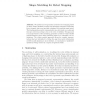14 search results - page 2 / 3 » A Recurrent Model of Orientation Maps with Simple and Comple... |
APIN
2006
13 years 5 months ago
2006
Biologists are building increasingly complex models and simulations of cells and other biological entities, and are looking at alternatives to traditional representations. Making ...
JCNS
2000
13 years 5 months ago
2000
We explore a computationally efficient method of simulating realistic networks of neurons introduced by Knight, Manin, and Sirovich (1996) in which integrate-and-fire neurons are ...
ALMOB
2006
13 years 5 months ago
2006
Background: Bifurcation analysis has proven to be a powerful method for understanding the qualitative behavior of gene regulatory networks. In addition to the more traditional for...
JCNS
2002
13 years 5 months ago
2002
We present a reduction of a large-scale network model of visual cortex developed by McLaughlin, Shapley, Shelley, and Wielaard. The reduction is from many integrate-and-fire neuron...
PRICAI
2004
Springer
13 years 10 months ago
2004
Springer
We present a novel geometric model for robot mapping based on shape. Shape similarity measure and matching techniques originating from computer vision are specially redesigned for ...

